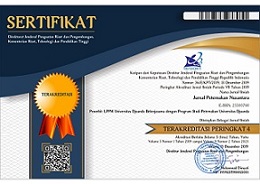THE USAGE OF FUNGI Trichoderma harzianum AND Aspergillus niger ON FERMENTATION OF BANANAS CORM (Musa sp.)
DOI:
https://doi.org/10.30997/jpnu.v4i2.1536Abstract
The purpose of this study was to study the interaction between dosages of fungi (T. harzianum & A. niger) and fermentation duration on protein content, crude fiber of bananas corm, and to determine the best treatment in fermentation. The method used is a Completely Randomized Design (CRD) with factorial pattern. The first factor (D) is the dose of fungi (T. harzianum and A. niger): 0.1%; 0.2% and 0.3% and the second factor (L) the fermentation duration: 24 hours, 48 hours, 72 hours and 96 hours. All treatments were replicated two times. The variables that measured are: protein content and crude fiber content of the material. The data obtained were tested by F test, then Duncan analysis was carried out. The results of the experiment showed the interaction effect between the both factors on the protein content and the crude fiber of banana weevils. The treatment T. harzianum at a dose of 0.3% and 72 hours of fermentation gave the highest protein content and the lowest crude fiber in bananas corm.
Key Word : banana weevil, fermentation, crude fiber, protein
Downloads
References
Agustono, Andy Setyo Widodo dan Widya Paramita. 2010. Kandungan Protein Kasar dan Serat Kasar pada Daun Kangkung Air (Ipomoea aquatic) yang Difermentasi. Journal Ilmiah dan Kelautan Vol.2 No 1. April 2010. Fakultas Perikanan dan Kelautan Universitas Airlangga.
Gong, C. S. Dan G. T. Tsao, 1979. Cellulase and Biosynthesis Regulation. Di dalam D. Pearlman (ed). Anual Report on Fermentation Process. Academic Press. New York
Junialdi Kamdra, Shafira Fiona, Ellyta, Elly Desni Rahman (2010). Maksimalisasi Glukosa dari Ampas Tebu dengan Hidrolisis Enzimatis Menggunakan Trichoderma viride dan Aspergillus niger Sebagai Bahan Baku Bioetanol. http://ejurnal.bungahata.ac.id/index.php?journal.
Laskin, D. L and A. L Hubert. 1973. Hand Book of food tekhnology. The AVI publishing co. Inc. Westpost, Connecticut
Nurhayati H.Muhiddin, Nuryati Juli dan I Nyoman P Aryantha,(2000)”Peningkatan
Kandungan Protein Kulit Umbi Ubi Kayu Melalui Proses Fermentasi ”JMS vol 6 no. 1hal 1 -12
Oboh, G dan Elusiyan, C.A. 2007. Changes in the Nutrient dan Anti Nutrient Content of Micro-Fungi Fermented Cassava Flour Produced From Low and Medium Cyanide Veriety of Cassava Tubers. African Journal of Bioetchnology 6 : 2150-2157
Supriyati, T. Pasaribu, H. Hamid dan A Sinurat. 1988. Fermentasi Bungkil Intisawit Secara Substrat Padat dengan Menggunakan Aspergillus niger JITV 3 (3) 165-170.
Umminani Hatta, Ostar Sjotjan dan B. Sundu. Pengaruh Fermentasi Kombinasi Jamur Pleurotus ostreatus dengan Trichoderma viride Terhadap Kandungan Nutrien dan Aktivitas Enzim Selulase Bungkil Kopra. Jurnal Ilmu-Ilmu Peternakan 24(2): 20-30 ISSN : 0852-3581
Wizna, H. Muis A. Deswan. 2014. Pengaruh Dosis Inokulum dan Lama Fermentasi Campuran Dedak Padi dan Darah dengan Bacillus amyloliquefaciens terhadap Kandungan Serat Kasar, Kecernaan Serat Kasar dan Energi Metabolisme. Jurnal Peternakan Indonesia Vol. 16 (2) hal 128-133.
Yohanes, M. Lucia, D.D dan Sri Hartini. 2010. Pengaruh fermentasi terhadap Kandngan Protein dan Asam Amino pada Tepung Gaplek yang Difortifikasi Tepung Kedelai (Glycine max L). Agritech, Vol. 36, No. 1 Februari 2010.
Downloads
Published
How to Cite
Issue
Section
License
Authors who publish with Jurnal Peternakan Nusantara agree to the following terms:
- Authors retain copyright and grant the journal right of first publication with the work simultaneously licensed under a Creative Commons Attribution 4.0 International License that allows others to share the work with an acknowledgement of the work's authorship and initial publication in Jurnal Peternakan Nusantara.
- Authors are able to enter into separate, additional contractual arrangements for the non-exclusive distribution of the journal's published version of the work (e.g., post it to an institutional repository or publish it in a book), with an acknowledgement of its initial publication in Jurnal Peternakan Nusantara.
- Authors are permitted and encouraged to post their work online (e.g., in institutional repositories or on their website) prior to and during the submission process, as it can lead to productive exchanges, as well as earlier and greater citation of published work.










